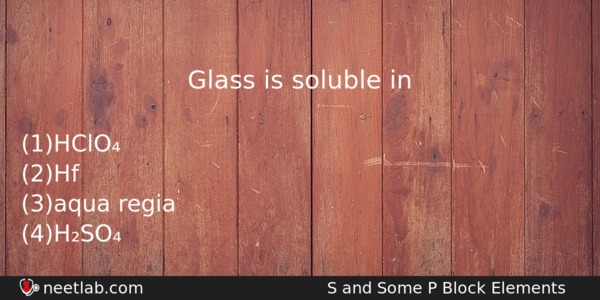| ⇦ | 
| ⇨ |
Glass is soluble in
Options
(a) HClO₄
(b) Hf
(c) aqua regia
(d) H₂SO₄
Correct Answer:
Hf
Explanation:
Unlike other halogen acids, HF acid attacks silica and glass. Glass being a mixture of sodium and calcium silicates reacts with HF forming soluble sodium and calcium fluorosilicates respectively. e.g., Na₂SiO₃ + 6HF → Na₂SiF₆ + 3H₂O, CaSiO₃ + 6HF → CaSiF₆ + 3H₂O.
Related Questions: - One mole of an ideal gas at 300 K is expanded isothermally
- Carborundum is
- The number of oxygen atoms in 4.4g of CO₂ is
- The pyknometric density of sodium chloride crystal is 2.165 x 10³ kg m⁻³,
- According to MO theory which of the following lists ranks the nitrogen species
Topics: S and Some P Block Elements
(157)
Subject: Chemistry
(2512)
Important MCQs Based on Medical Entrance Examinations To Improve Your NEET Score
- One mole of an ideal gas at 300 K is expanded isothermally
- Carborundum is
- The number of oxygen atoms in 4.4g of CO₂ is
- The pyknometric density of sodium chloride crystal is 2.165 x 10³ kg m⁻³,
- According to MO theory which of the following lists ranks the nitrogen species
Topics: S and Some P Block Elements (157)
Subject: Chemistry (2512)
Important MCQs Based on Medical Entrance Examinations To Improve Your NEET Score
18000+ students are using NEETLab to improve their score. What about you?
Solve Previous Year MCQs, Mock Tests, Topicwise Practice Tests, Identify Weak Topics, Formula Flash cards and much more is available in NEETLab Android App to improve your NEET score.
Share this page with your friends

Leave a Reply